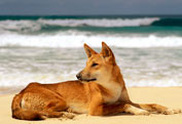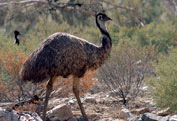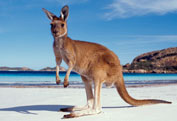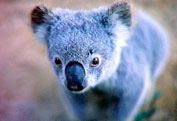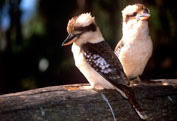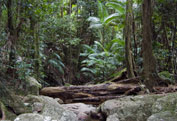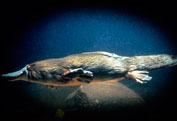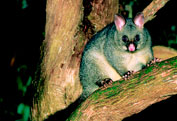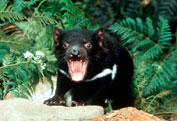Australia teems with native animals, many which are found only here. We
have more mammals than anywhere else on earth and plenty of marsupials,
from carnivorous Tasmanian devils to short-legged possums, sleepy koalas
to powerful kangaroos. We’re home to 350 species of unique birds,
including the iconic kookaburra and emu. See Australia’s native animals
in zoos and wildlife parks across our major cities and tourist centres -
Sydney’s Taronga Zoo, the Rainforest Habitat in Port Douglas,
Victoria’s Healesville Sanctuary and South Australia’s Cleland Wildlife
Park to name a few. Or observe them in their natural habitat, on your
own or on a specialised tour with expert commentary.
|
|
Dingos
The dingo is Australia’s wild dog, though is not native to the continent. Dingoes are medium-sized, with broad heads, pointed muzzles, erect ears, bushy tails and red to yellow coats. They have longer muzzles, longer canine teeth and flatter skulls than similarly sized domestic dogs. Dingoes are carnivores, commonly feeding on kangaroos, wallabies, cattle, wombats and possums. Dingoes are highly social creatures and form stable packs with clearly defined territories where possible. They communicate mostly through howling and whimpering and bark less than domestic dogs. Dingoes are found all across Australia, except for Tasmania. Catch a glimpse on Queensland’s Fraser Island, in Western Australia’s Kimberly and across the deserts of the Northern Territory and South Australia. |
|
Emu
The emu is a large, brown, soft-feathered, flightless bird. Emus grow up to two metres tall and have three toes and long legs that allow them to run very fast, up to 50km per hour. The female emu is larger than the male and lays up to 20 large, dark green eggs. The emu appears on the Australian 50 cent coin and alongside the red kangaroo on the Australian Coat of Arms. It is also a recurring figure in Aboriginal mythology. The emu avoids populated areas and feeds on grass, leaves and small insects. You’ll see emus in grasslands, sclerophyll forests and savanna woodlands all over Australia. |
|
|
|
Kangaroo
The kangaroo is unique to Australia and appears on our coat of arms. It is a mammal and a macropod, a family of marsupials that includes wallabies and pademelons. Kangaroos are the only large animals to travel by hopping and breeding adult males often fight by boxing with their front paws and kicking their back legs. There are 55 kangaroo species spread across Australia. In Victoria, see them in Anglesea on the Great Ocean Road and in the Grampians. Spot them in South Australia’s Kangaroo Island and Flinders Ranges. Get up close in Namadgi and Kosciuszko National Parks in the Australian Alps, in Pebbly Beach in New South Wales and Tasmania’s Maria Island. |
|
Koala
The koala is a unique Australian marsupial. It is sometimes referred to as a koala bear because of its similarity in appearance to a teddy bear. It also looks like the wombat, its closest living relative, but has a thicker coat, larger ears and longer limbs. Koalas are only active for around two hours a day and get all their fluids from eating eucalyptus leaves. You can spot koalas all along Australia’s temperate eastern coast. Some of their top hangouts include Tidbinbilla Nature Reserve, near Canberra, around Port Stephens in New South Wales and the Lone Pine Koala Sanctuary in Queensland. Observe them in the wild on Victoria’s Phillip Island and Yanchep National Park in Western Australia. |
|
|
|
Kookaburra
Australia’s kookaburra is the world’s largest kingfisher. Similar to other kingfishers, kookaburras have a stout and compact body, short neck, long and pointed bill and short legs. They’re native to Australia’s east coast and were introduced to Western Australia in 1898. Kookaburras are best known for their hysterical, human-sounding laughter at dusk and dawn. They also often sing as a chorus to mark their territory. Kookaburras are carnivores but will eat almost everything. They are territorial, and often live with the partly grown chicks of the previous season. You’ll spot them in the city suburbs, but more commonly in the countryside. |
|
Lyrebird
The lyrebird is a ground-dwelling Australian bird, known for its ability to mimic any sound it hears– from car engines and fire alarms to crying babies. The lyrebird is named after the male’s spectacular, 16-feathered tail, which was thought to resemble a lyre in the 1800s. There are two species of lyrebird. Spot the smaller Albert's Lyrebird in Mt Warning National Park and in the Gondwanan rainforest around the Gold Coast hinterland. See the more common superb lyrebird in Dandenong Ranges and Kinglake National Parks around Melbourne and the Royal National Park and Illawarra region south of Sydney. You’ll find them in Tidbinbilla Nature Reserve, near Canberra, and many other parks along Australia’s east coast. |
|
|
|
Platypus
Platypuses are small, dark-brown, furry, egg-laying mammals with webbed paws and a duck-like beak. Platypuses live in burrows which they dig into the banks of rivers. They are diving animals, and can stay under water for up to fifteen minutes. Unlike a duck's beak, the platypus' beak is rubbery and flexible. It has hundreds of electroreceptor cells inside it, which can detect the electrical currents that are caused by its prey swimming through the water. Platypuses can be found along Australia’s eastern coastal areas in small streams and quiet rivers. See them in Tidbinbilla Nature Reserve near Canberra, on Lake Elizabeth in Victoria’s Great Otway National Park and in Tasmania’s Cradle Mountain-Lake St Clair National Park. |
|
Possum
Possums are small marsupials with brown or grey fur. Australia’s 69 possum species range from pygmy possums and wrist-winged gliders the length of a finger, to brushtails and ringtails the size of a domestic cat. All possums are nocturnal and omnivorous, hiding in a nest in a hollow tree during the day and foraging for food at night. Possums have long played a part of Australian culture and folklore. Aboriginal Australians used possum hides whilst playing Marn Grook, a traditional ball game at gatherings and celebrations. In Australia’s south-east, Aboriginal people used possum-skin to make cloaks and clan heirlooms. Today you’ll see possums in urban areas and city parks. |
|
|
|
Tasmanian devil
The Tasmanian devil is a carnivorous marsupial with the appearance of a small, stocky dog. It has a broad head, thick tail and coarse, black fur. The Tasmanian devil was given its common name by early European settlers, who were haunted at night by its screeches and demonic growls. Despite its appearance and reputation, the Tasmanian devil is actually a shy creature. It is the world’s largest carnivorous marsupial since the Tasmanian tiger became extinct in 1936. Since 1995 Tasmanian devils have been ravaged by devil facial tumour disease, and as a result are now a protected species. See them in Tasmanian wildlife parks, such as Taranna on the Tasman Peninsula. |
|
Wallaby
The name wallaby comes from Sydney’s Eora Aboriginal tribe. It refers to about 30 species of macropods which are smaller than a kangaroo or wallaroo. The most common species are the agile wallaby and red-necked wallaby, which look very similar to kangaroos and wallaroos, and are frequently seen in the southern states. Rock-wallabies specialise in rugged terrain and have modified feet designed to grip rock rather than dig into soil. Very small forest-dwelling wallabies are known as pademelons. Wallabies are widespread across Australia, particularly in more remote, rocky and rugged areas. Spot them in South Australia’s Flinders Ranges, Tasmania’s Freycinet National Park and in Namadgi and Kosciuszko National Parks in the Australian Alps. |
|
This page is thanks to www.australia.com, and google images, it can be found here.
